Last month’s post was about visiting Maidenhead. This month I have the chance to write about a somewhat more exciting trip: to Venice. In defence of Maidenhead, I’m near enough to do it as a comfortable day trip, returning with a car full of ceramics. For a lover of glass and ceramics however, there are few places better than Venice.
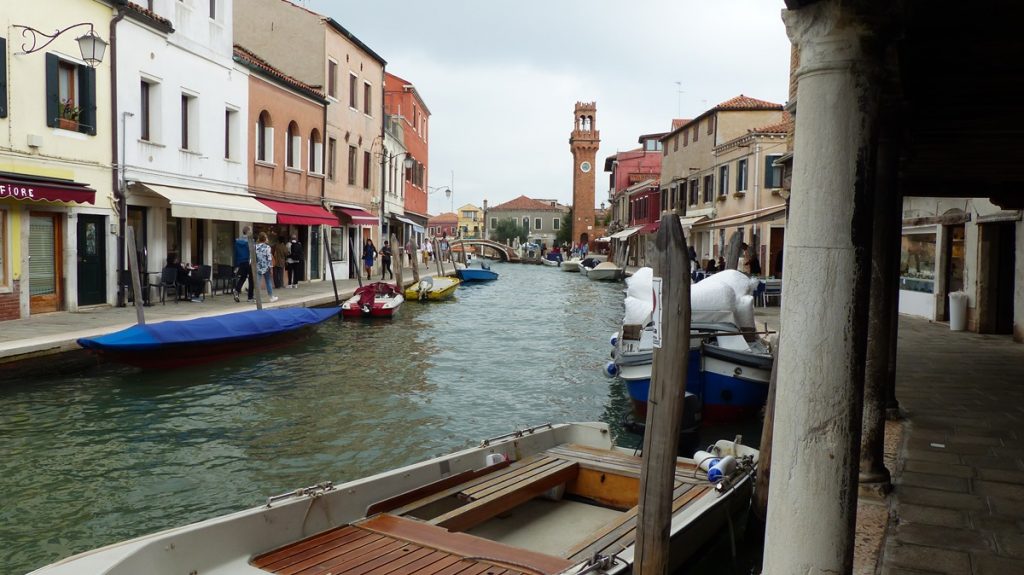
A repeat visit but I’m still overwhelmed
I’m always overwhelmed by Venice, even though this was my fifth visit. I grew up in York and would happily compare parts of its medieval centre with anywhere, but the thing with Venice is that the whole place is amazing. No matter where you walk around the islands you never seem to get into anywhere that looks like a “normal” city. The absence of conventional traffic makes a huge difference. There are of course a lot of boats but that just enhances the atmosphere.
Into Venice, for about three hundred years, tourists have walked open mouthed to have money extracted in exchange for a few souvenirs. For much of that time tourism has been based around the glass industry centred on the island of Murano. If you’re hoping for a detailed, expert guide to buying glass on Murano I’m afraid you’ll have to look elsewhere. What I can offer are my experiences as someone who buys and sells glass at home, sometimes to tourists. I also understand shop-keepers and their body-language somewhat better than I used to be able to, which is always a useful skill when you’re a potential customer.
We arrived in Venice on a Sunday in September, flying from Birmingham. The city didn’t feel packed, but was comfortably lively. Away from the immediate centre, walking was pleasant and comfortable. Venice has a reputation for being very expensive both to stay and to eat. I would say that it pays to do your research and try to book well in advance. The hotels we’d used previously weren’t as affordable as they once were. However, the hotel we did use was really excellent and was no more expensive than an equivalent in any other popular western European city.
Take your time, if you can
If you’re visiting to buy some art glass, I think you really need at least three days. You’ll find a huge selection in shop after shop, so try not to make hasty purchases. After a while you’ll start seeing some of the designs over and over again. You’ll also start to see some price variation. In Venice, it’s easy to get lost. It’s one of the joys of the place. However, if you see something you like and might want to come back to, make a note of where you are. Don’t assume you can refind a shop unless it’s right outside your hotel.
To my mind there are really three levels of art glass available. A couple of conversations we had with shopkeepers reinforced this as they justified why a couple of pieces we looked at were significantly more expensive than others in their shops.
Knowing your level
At the entry level, artisans create items from glass rods, heated over a flame. The glass is bent, stretched, compressed and fused to other pieces of rod. This allows the fabrication of a whole range of small items, some of which are very attractive. However, if you’ve ever seen the Scarborough Lucky Duck shop you’ll know making this sort of thing requires a limited amount of equipment and you don’t need to go to Venice to buy them.
You’ll frequently see notices in the shops about cheaply imported products being sold as Venetian. This had long been a complaint from shopkeepers. The accusation us usually aimed at China, but I don’t know whether this is based on fact or is just a lazy racist rant. I haven’t heard that any comes from Scarborough, but maybe the Venetians haven’t realised the danger?
If you want to buy items like this, take your time and try to find the shops where you can see people working over gas torches. Joking aside, it is a genuine skill and is absorbing to watch. These shop are, of course, the most satisfying to buy from.
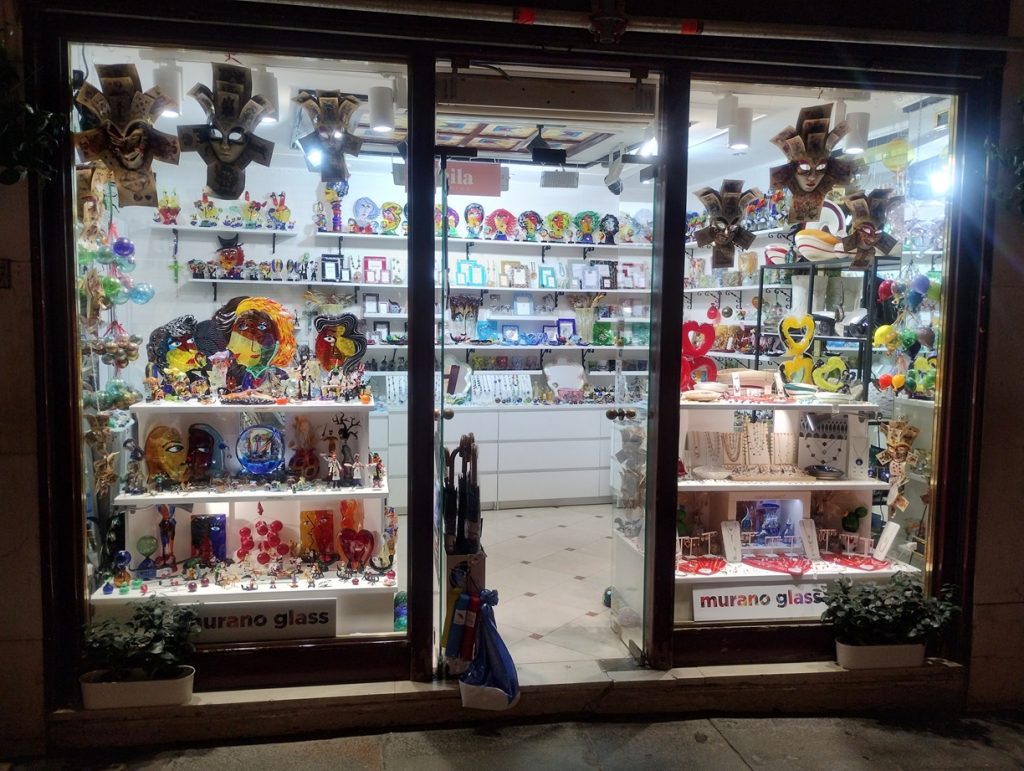
If you’re around for a few days, take time to get away from the most popular areas and you’ll see prices drop. When there’s a cruise ships in port their day trippers swamp the city. These visitors have little time available for shopping, or indeed for anything else. Inevitably they buy from the shops in the most popular areas, consequently paying for their lack of time.
Furnace work is where it’s at
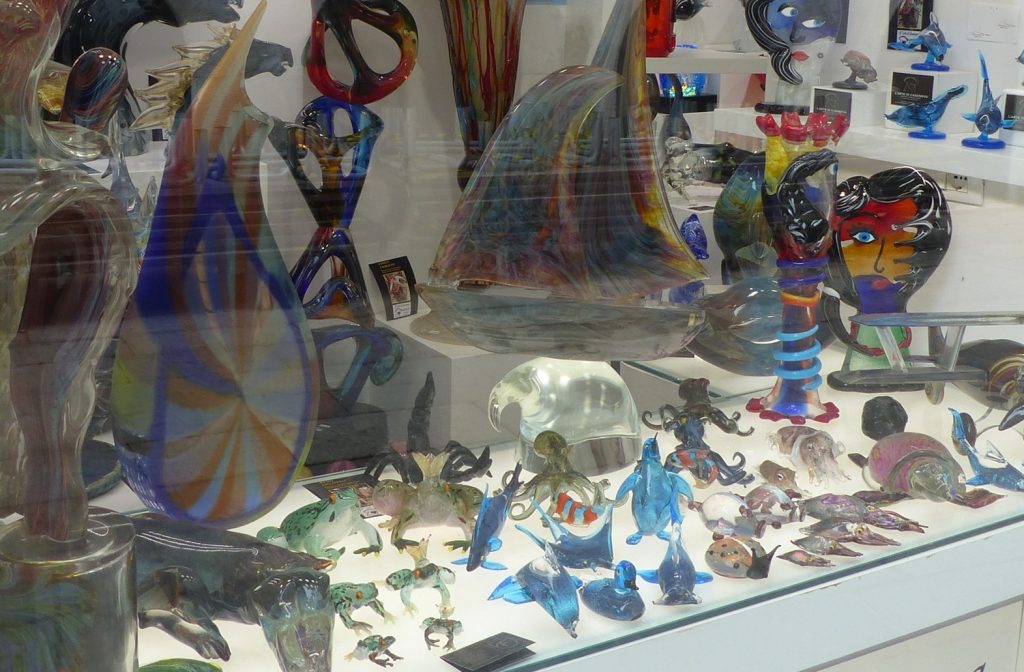
The second level of glasswork probably starts around the 50 Euro mark. This is the entry level for items made in a furnace. For most collectors, this where you start. The range is wide but generally consists of figures or sculptures (frequently of animals and birds), paperweights and plates or dishes. Prices typically go up to a few hundred Euros.

wonderful displayed on a mirror)
For this level of piece you should at least make a visit to Murano as you can find a really good range of shops close together. There are some good suppliers in Venice itself that are worth a look too. Two I really like are just at the foot of the western end of Rialto Bridge, one either side of the main street. In spite of their obvious tourist trap location, both seemed reasonably priced and had excellent quality stock.
Murano, a Mecca for glass collectors
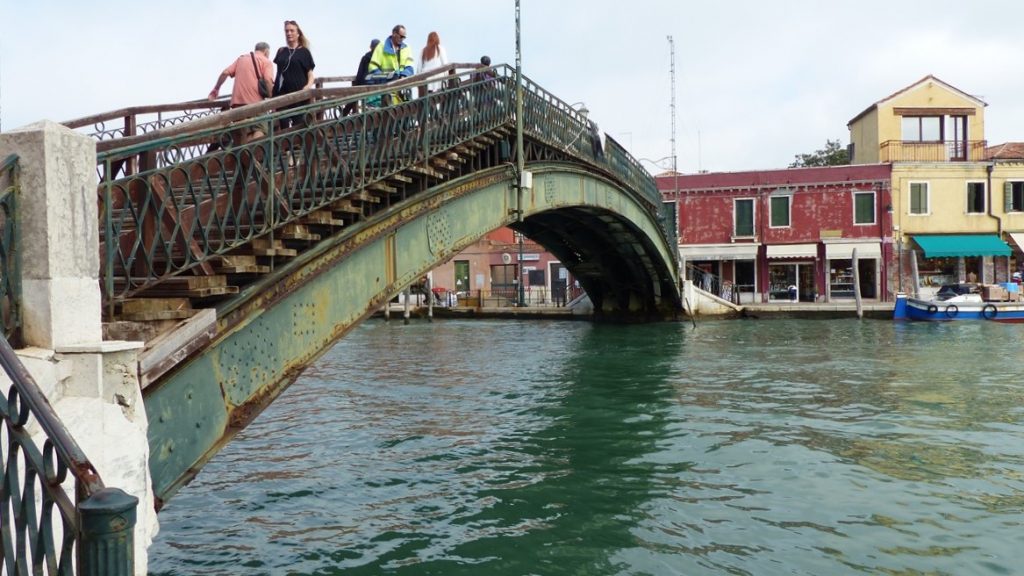
The trip out to Murano is a joy in itself because it involves another boat ride. I like to stay on the boat to the lighthouse (Faro) stop and then to walk up Calle Bressagio. Don’t try to get here too early to avoid the rush. It’s never very busy and you’ll be waiting for the shops to open (usually around 10:00 a.m.). The glass shops here are numerous and you’ll see a lot of very expensive pieces. Another advantage of Murano is that it’s not so big that you forget the pieces you might want to consider.
The glass shops on Murano are typically larger than in Venice. The shop layouts usually allow plenty of room to move around, but you need to be wary all the time. This isn’t a day to be carrying a large rucksack on your back. If you are planning on buying a large, glass giraffe you’re not going to risk it in your rucksack anyway, so leave your big bags at your accommodation.
Ask before you snap…
You’ll probably notice that some of the shops don’t allow photography. I have to say I have mixed feelings about this. Originally I guess this was to stop people stealing designs but today that’s completely unrealistic. Anyone intent on getting images of a piece of art glass can discreetly walk around filming on a phone. I completely understand not wanting people taking selfies in a shop full of glass but there’s a whole range of other inappropriate conduct I’ve seen that would be far more worrying than someone taking the odd photograph.
In my experience, very large dogs, bored children and people who need to lean on the cabinets to steady themselves are far more worrying than a few holiday snaps.
Doing your research
Murano is a glass buyers dream. There really is a wide range to choose from, but surprisingly there was actually very little sign of glass working. The island is quite large so maybe there’s a whole host of glass working going on behind closed doors. In the end, we only saw a couple of places where furnaces were visible. I suspect, if you’re really interested, tours will be available.
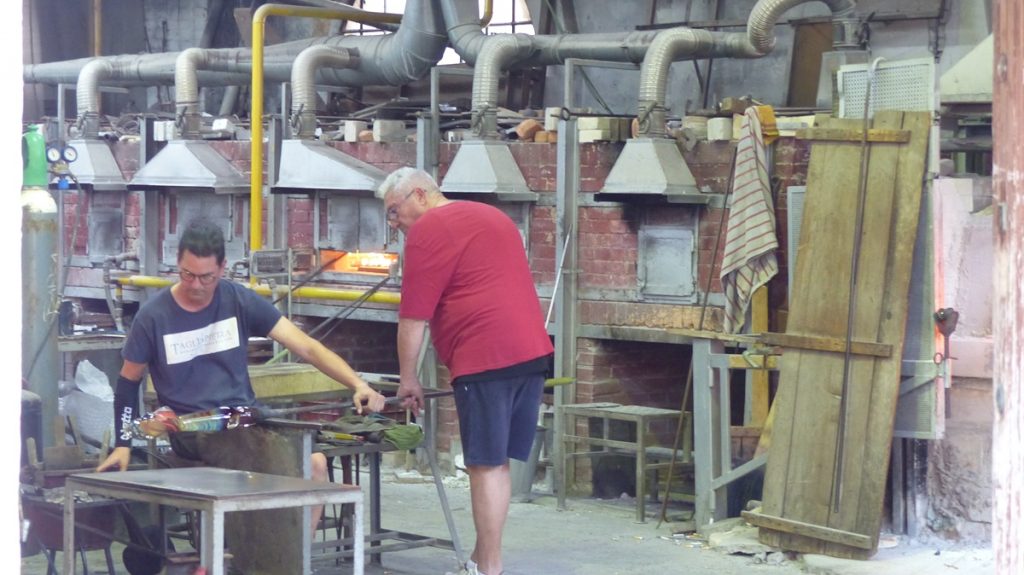
You shouldn’t buy on impulse unless you have no choice and plenty of money. Beyond the obvious comment that hand made glass items are by their nature unique, be wary of anyone telling you a piece is unique. During a previous visit, a travelling companion studied a piece of glass he was assured was unique, only to find the same design elsewhere a couple of days later. Sales people are skilled at saying what they think the customer wants to hear.
Regardless of where you buy, if you’re paying over about 50 Euros ask whether the piece was made locally. Ideally your item will have some sort of identification marker or even just a label. This is never a guarantee but it’s a good start. If not, the best you can ever say is that you went to Venice and bought some glass.
Going Large
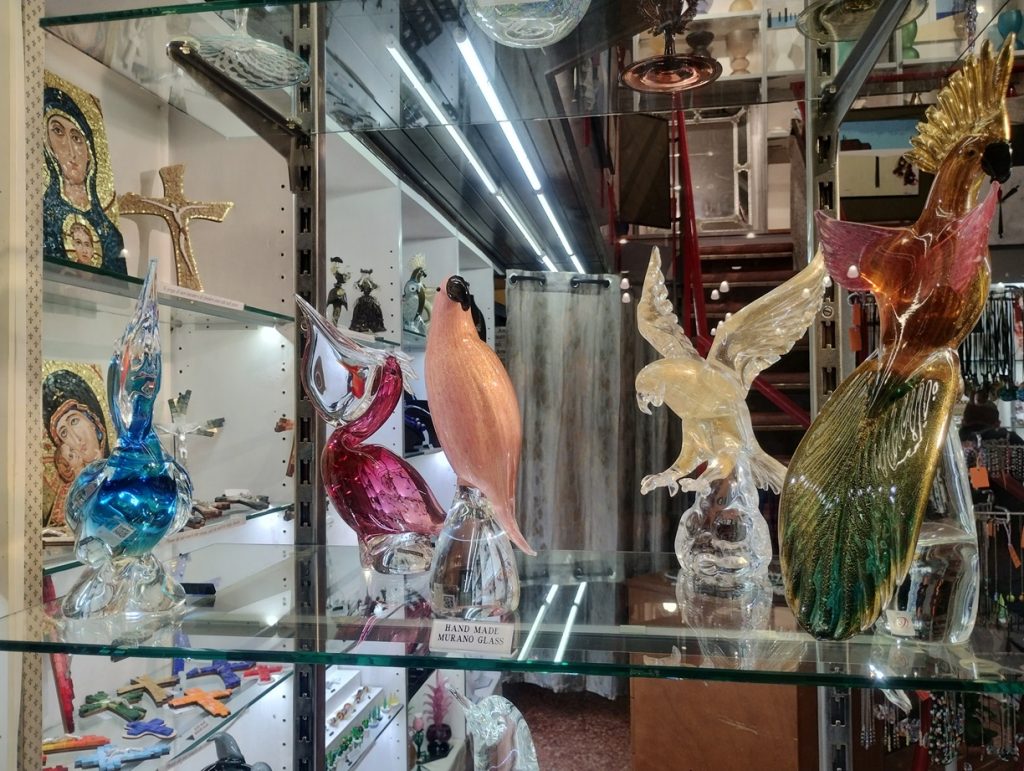
The final level of art glass probably starts at about 500 Euros and keeps going up. There are lots of pieces to choose from, but if you’re paying that sort of money you might think about commissioning what you want. At least on Murano you can see the work of local artists and can decide which one is getting your business.
If I’m being honest with the larger pieces, whilst clearly technically stunning, few of them are things I’d want at home. Maybe large hotels or company headquarters feature them as statement pieces, but the meaning of the statement remains rather lost on me. I like my glass at a size I can pick up and admire it as it changes in the light.
Buy what you like, because it’s not going to make you rich
Whatever you end up buying (and if you can afford to get to Venice you really should save a bit for a decent souvenir), don’t expect to make money on it. The sale rooms of Britain regularly get Venetian glass to sell and, like ceramics and paintings, resale value will probably be about half what you paid new. Age doesn’t help either.
Like all forms of art, as time passes tastes change and styles move with them. Unless you have a piece by an artist whose work becomes more appreciated in time then values will stay the same or fade a little.
I was pleased to see some painted red glass vases on Murano made in a style I associate with the 1960s. An uncle of mine brought something similar back for his mother (my grandmother) when he was on a cruise. The vases remain in my family, although I suspect my uncle paid in real terms far more than they are worth today. There was definite twinge of emotion for me though at the thought my uncle was somewhere around there 60 years ago, choosing some pieces for his mother as a souvenir. I’m sure they were appreciated.
You might be surprised to learn that once you get above about 100 Euros, you can ask about a discount on the price. It may have been because the peak season had passed but we were offered (without asking) discounts on each of the pieces we looked at closely. In addition, if you are travelling to outside the EU you can ask to reclaim the sales tax. The desk at the airport is clearly marked, if you have time and can handle a bit of paperwork.
Getting your purchases home
If you happen to be reading this in Venice, then this bit of advice is probably a bit late. If you’re thinking of buying glass and taking it home, start your planning before you leave. Have a think about how you’re going to transport your purchases.
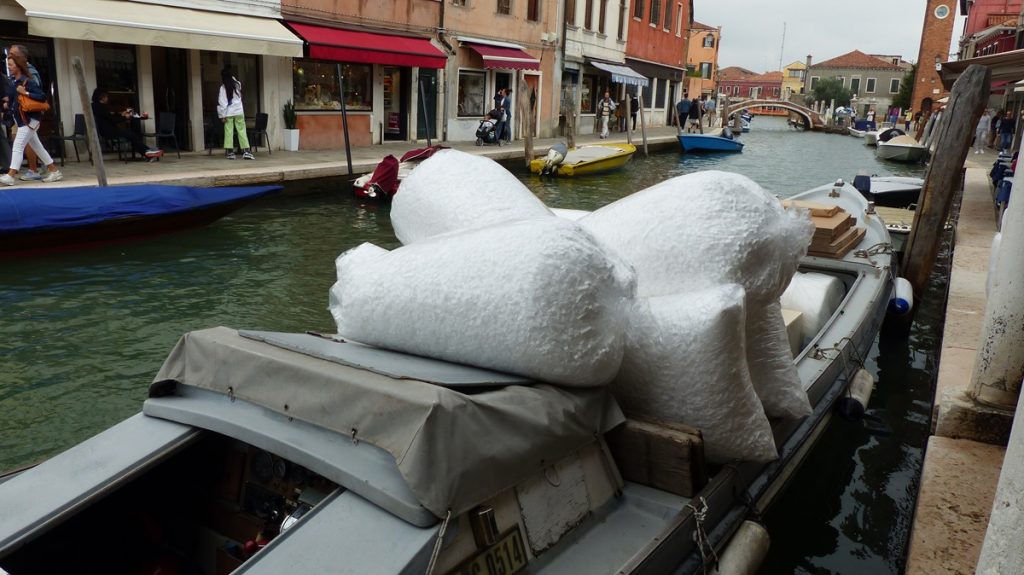
Simply getting someone to ship a piece is fine, but it’s expensive and probably no more certain than carrying it yourself. The locals regularly handle shipping and packing. We saw a couple of boats piled high with packaging but really unless you’re paying a very great deal for an item you’re probably taking it home in hand luggage.
I know from selling items to overseas buyers in the shop, many people put huge faith in bubblewrap. It’s certainly a good start but it’s not going to save an item from crushing. Along with bubblewrap, towels, jumpers and fleeces make excellent packaging but you need a hard sided suitcase or strong box. In the end though, we prefer to carry our breakables.